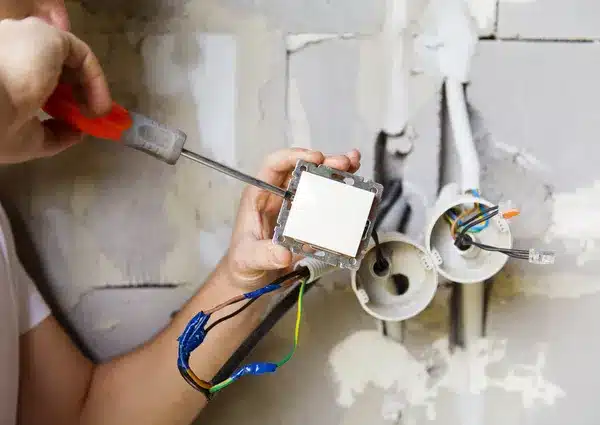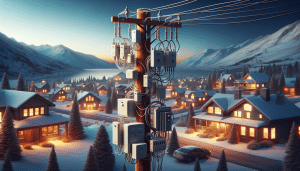You flip a switch and nothing happens — or worse, the light flickers like it’s trying to signal Morse Code. Annoying, yes; harmless, not always. If you live in Salt Lake County, Davis County, or Utah County and you’ve ever muttered “not again” while wrestling with a stubborn outlet or a breaker that won’t behave, you’re not alone. Electrical quirks are part of owning a Home, but a lot of them are fixable, fast, and far less scary when a pro handles them. Let me explain what a Residential electrician from Black Rhino Electric commonly sees and what they’ll do about it — in plain English, with a little grit and a few real-world tips.
Contents
- 1 Flickering lights — more than mood Lighting
- 2 Breaker trips — they’re annoying, but they’re trying to tell you something
- 3 Warm outlets or scorch marks — don’t shrug it off
- 4 Outlets that are dead or intermittent — it’s not always the outlet
- 5 Old panels and sketchy wiring — nostalgia isn’t worth the risk
- 6 Buzzing, humming, or strange smells — small sounds, big clues
- 7 Smart home installs and EV chargers — modern life needs modern wiring
- 8 DIY fixes — tempting, but there’s a reason pros exist
Flickering lights — more than mood Lighting
Flicker isn’t just an aesthetic problem. Often it’s loose connections at a fixture or switch, or a shared neutral that’s overloaded when heavy appliances kick on. Sometimes it’s a tired bulb or fixture; sometimes it hints at a loose wire in the ceiling box or at the panel (which is riskier). An electrician will trace the circuit, test voltage with a Fluke meter, tighten connections, and replace any failing hardware.
Widgets and smart bulbs can complicate things, too. You replace the bulb and the flicker’s gone — great — but if it comes back when the microwave runs, you’ve got a load issue, not a bulb. Simple tests narrow it down fast.
Breaker trips — they’re annoying, but they’re trying to tell you something
When the breaker trips, it’s your house calling: “Too much on this circuit!” Usually it’s an overloaded circuit (space heaters, multiple power strips, holiday lights), a short, or a defective breaker. Occasionally it’s a warning about an aging panel that can’t handle modern loads. Here’s how an electrician approaches it:
- Check the load. They’ll map out what’s on that breaker — outlets, lights, appliances — and redistribute heavy loads.
- Inspect the breaker. Defective Breakers happen (yes, even brand-name Panels like Square D or Eaton can have wear). Replacing a breaker is quick; replacing an old panel is more involved.
- Look for shorts or ground faults. These need careful diagnosis to prevent repeat trips or fire risk.
And here’s the thing: if your panel was installed before you were born (or before your home had a dishwasher), you might need an upgrade. It’s not dramatic — just sensible.
Warm outlets or scorch marks — don’t shrug it off
If an outlet feels warm, or you spot discoloration, melting, or burn marks, call someone now. That warmth usually means a loose connection, overloaded outlet, or damaged wiring — all of which increase fire risk. An electrician will remove the receptacle, inspect the wiring, test the connection, and replace the outlet and any compromised wiring. It’s tedious, sure, but much cheaper than replacing a wall or worse.
Outlets that are dead or intermittent — it’s not always the outlet
One outlet disappears; another works fine. Or an outlet only works when you jiggle the plug. Usually it’s a loose wire or a tripped GFCI that’s protecting other outlets downstream. Electricians use a receptacle tester and continuity checks to locate the problem. Sometimes the fix is a five-minute tighten. Sometimes it means re-terminating wires in a junction box or replacing a corroded outlet.
Old panels and sketchy wiring — nostalgia isn’t worth the risk
Older homes have character. They sometimes also have knob-and-tube wiring, aluminum wiring, or antique panels like some Federal Pacific or Zinsco models that are known to be problematic. Aluminum wiring, for example, oxidizes and can loosen at terminals leading to heat and arcing — not good. There are industry-approved solutions (pigtailing with copper using methods such as COPALUM is one example), but those require a licensed electrician and, usually, a permit.
Permits and inspections aren’t bureaucratic red tape — they’re a safety handshake with your county, whether you’re in Salt Lake County, Davis County, or Utah County. Trust me: the peace of mind is worth it.
Buzzing, humming, or strange smells — small sounds, big clues
A low hum from the panel isn’t always dramatic, but a new buzzing accompanied by warmth or a metallic smell? That’s a red flag. Buzzing can be a loose lug in the panel, an overloaded circuit, or a failing component. The smell of ozone or burning insulation is even more serious. Electricians will shut down power if needed, methodically test components, and repair or replace as required. Don’t “see if it goes away” — it usually doesn’t.
Smart home installs and EV chargers — modern life needs modern wiring
Adding a smart thermostat, whole-house surge protection, or an EV Charger is exciting — and it can expose weaknesses in old wiring or undersized service. An EV charger, for instance, often needs a dedicated 240V circuit and sometimes an upgraded service panel. Smart devices can also create nuisance tripping if not installed on stable circuits. A qualified electrician will size the circuit, confirm the panel’s capacity, and handle local permitting. You get convenience — safely.
DIY fixes — tempting, but there’s a reason pros exist
Look, I get it: that project looks easy on YouTube. But electrical work has consequences. A wire tucked behind drywall can short months later. A poorly pigtail can overheat. Even replacing a receptacle can become dangerous if the neutral and ground are confused. A licensed pro carries the right tools, knowledge, and insurance — and that matters when you consider resale value, family safety, and homeowners’ insurance claims.
If any of this hits a nerve — or if you’ve got a nagging electrical problem that’s been creeping up — we can help. Black Rhino Electric works across Salt Lake County, Davis County, and Utah County fixing the stuff homeowners hate to deal with: flickers, trips, warm outlets, old panels, and the “I’ll just fix it later” problems. Call us at 801-810-4292, or Request a Free Quote today. Don’t wait until a small flicker becomes a big problem.




